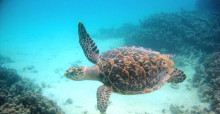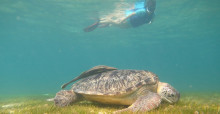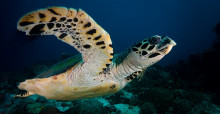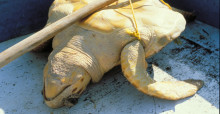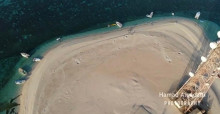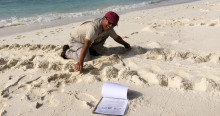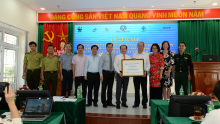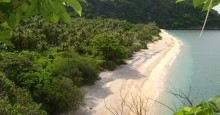Satellite tracking and flipper-tagging techniques have enabled a better understanding of marine turtle life histories.
Eretmochelys imbricata
The hawksbill (Eretmochelys imbricata) turtle is small to medium-sized compared to other sea turtle species. In the Indian Ocean region, adults weigh 45 to 70 kg, but can grow to as large as 90 kg. Female hawksbills return to their natal beaches every 2-3 years to nest. A female hawksbill may lay 3-5, or even more, nests per season, each of which contains an average of 130 eggs.
Hawksbill turtles, like other marine turtles, use different habitats at different stages of their life cycle, but this species is most commonly associated with coral reefs. Post-hatchlings (oceanic stage juveniles) are believed to occupy the pelagic environment. After a few years in the pelagic zone, small juveniles recruit to coastal foraging grounds. This shift in habitat also involves a shift in feeding strategies, from feeding primarily at the surface to feeding below the surface, primarily on animals associated with coral reef environments. Their narrow, pointed beaks allow them to prey selectively on soft-bodied animals like sponges and soft corals.
Hawksbill turtles are circumtropical, typically occurring from 30°N to 30°S latitude. In modern times hawksbills are solitary nesters (although some scientists postulate that before their populations were devastated they may have nested on some beaches in concentrations) and, thus, determining population trends or estimates on nesting beaches is difficult.
Although generally not found in large concentrations, hawksbills are widely distributed in the Indian Ocean. There, the largest nesting populations – which are among the largest in the world – occur in the Seychelles, Indonesia and Australia. Adult hawksbill turtles are capable of migrating long distances between nesting beaches and foraging areas, although the migration distances are generally not as long as those for green turtles.
Exploitation of hawksbills, primarily for their "tortoise shell" (the thick, overlapping, horny scutes that cover the shell), dates back millennia in the Indian Ocean. The shell was sought after for manufacture of diverse articles in both the Orient and Europe, and it constituted one of the most important trade commodities in a well developed trade network in the Indian Ocean. Many populations were decimated. However decades-long protection programmes in some places, particularly at several beaches in the Indian Ocean, have resulted in population recovery. Today, interactions with fisheries are especially important in coastal fisheries where nets are used.
The preceding biological information on marine turtle species found around the Indian Ocean is derived partly from the NOAA Fisheries, Office of Protected Resources, website:(http://www.nmfs.noaa.gov/pr/species/turtles/), supplemented by other sources (such as a website of the Australian Government, Department of Environment, Water, Heritage and the Arts -- for information on the Flatback turtle), and additional information supplied by Dr. Jack Frazier (IOSEA Advisory Committee Chair).
| CMS Instruments | CMS, IOSEA Marine Turtles, Atlantic Turtles |
|---|---|
| IUCN Status | Critically endangered |
| Date of entry in Appendix I | 1985 |
| Date of entry in Appendix II | 1979 |
| English | Hawksbill Turtle |
|---|---|
| French | Tortue Imbriquée, Caret |
| Spanish | Tortuga carey |
| German | Echte karettschildkröte |
| Class | Reptilia |
|---|---|
| Order | Testudinata |
| Family | Cheloniidae |
| Scientific name | Eretmochelys imbricata |
| Author | (Linnaeus, 1766) |
| Standard reference | Eckert, K.L., Bjorndal, K.A., Abreu-Grobois, F.A. and Donnelly, M. (Eds) (1999). Research and management techniques for the conservation of sea turtles. IUCN/SSC Marine Turtle Specialist Group Publication No.4. |
| Additional notes | In Effect 7/1/1999 |
|---|



